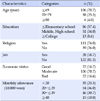INTRODUCTION
1. Background
2. Purpose
• To investigate the levels of perceived health status, psychological well-being, depression, and loneliness of elderly women living alone.
To determine the level of participation in leisure activities of elderly women living alone according to their general characteristics.
To determine if participation in leisure activities is correlated with variables such as perceived health status, psychological well-being, depression, and loneliness in elderly women living alone.
To identify the factors influencing the participation in leisure activities of elderly women living alone.
METHODS
1. Study Design
2. Data Collection and Participants
3. Measures
1) Participation in leisure activities
2) Perceived health status
3) Psychological well-being
4) Depression
5) Loneliness
4. Procedures
1) The preliminary survey
2) The main study
5. Data Analysis
The t-test and ANOVA were performed to determine the differences in the levels of perceived health status, psychological well-being, depression, and loneliness of the survey participants according to their level of participation in leisure activities.
The general characteristics and the levels of perceived health status, psychological well-being, depression, and loneliness of the survey participants were analyzed using descriptive statistics such as frequency and mean.
The correlations among the research variables were examined using Pearson's product moment correlation coefficient.
To explain the variables that affect the participation in leisure activities of the study subjects, all the significant factors were included as response variables and were analyzed using stepwise multiple regression analysis. The Durbin-Watson test was used to independently measure the autocorrelation of errors to confirm if all the assumptions of the regression analysis were satisfied. In addition, tolerance as an indicator of multicollinearity, and the variance inflation factor (VIF), were calculated and analyzed.
In relation to the perceived health status, psychological well-being, depression, and loneliness according to the subjects' participation in leisure activities, the significant variables were analyzed using the Scheffé post-hoc test.




 PDF
PDF ePub
ePub Citation
Citation Print
Print








 XML Download
XML Download